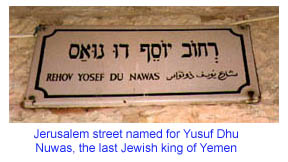|
When We Were Kings
The Jews of Yemen, Part II
By Nehama C. Nahmoud
The most exciting and glorious period in the
The Arabs in pre-Islamic days were out-and-out idol worshippers; but
those who lived in the cities, of course, were in constant contact with
the large Jewish populations there, and even the Bedouin tribes who
lived in the desert were familiar with the "People of the Book."
Moslem legend tells of a desert sheik, Tub'a Abu Kariba As'ad, who
reigned as king of Yemen from 390 to 420 CE. He took his tribe north
from Yemen to Medina (now part of Saudi Arabia) to fight the Jews of
that city. But instead of conquering, he himself was conquered -- by
the words of Medina's rabbis. He returned home with two Jewish scholars
in tow and became a convert. His tribesmen were at first reluctant to
give up their ideas and way of life, but Abu Kariba convinced them of
the truth of Judaism and they, too, accepted the yoke of the Creator,
thus beginning the Jewish kingdom of Himyar, as Yemen was called during
that period.
Accompanying this legend, archeologists have uncovered an interesting
inscription from that period, carved in stone, with a sentence in
ancient Hebrew appearing in the middle. The inscription tells about a
building erected by a man whose first name was Yehudah and continues,
"with help and charity of his G-d, the creator of his soul, the G-d of
the living and the dead, the G-d of heaven and earth, who created
everything; and with the support of His people, Israel; and by the
authority of the King of Sheba; and by the authority of his tribal
lord." The content of the inscription is very different from Christian
inscriptions of the same period.
YUSUF DHU NUWAS
Sheikh Yusuf Dhu Nuwas (517-525 CE) was the last Jewish king of Yemen
and was himself a convert. He inherited an inevitable situation from his
weaker predecessor. When Dhu Nuwas began his reign, the kingdom was in a
general state of deterioration, and the Ethiopians, meanwhile, had not
lost a minute. They had moved their army into several cities, including
the capital -- even turning the main synagogue into a church -- all
without shedding a drop of blood.
Neighboring Ethiopia had become Christian circa 327 C.E., during the
reign of the Roman Emperor Constantine, who ruled from the Greek capital of Byzantium, and it was bent on expanding its spiritual, if not temporal, territory. The Ethiopians had
infiltrated into Yemen gradually over the years since their embracing of
Christianity. Backed by Christian Byzantium, they had made repeated
efforts at missionizing among the Yemenites.
Among Dhu Nuwas' first acts as king was to unite all the princely factions in his territory into an effective army and to go into action. Sarhil Yakbal, one of his prince-commanders, wrote a description of Nuwas' Ethiopian wars, the highlights of which were the battles of Ta'afar and Najran.
The battle of Najran appears to have been an event which shook the
entire region: some believe to have found an echo of this battle even in
the Koran itself, as well as in Christian literature of the era. In
fact, three related inscriptions were discovered near Najran in the
1950s, one of which gives us an intimate peek into life in Najran.
It describes the city as a hotbed of Christian agitation against the
king, ending in a revolt in which some Jews were killed. Christian
sources acknowledge that the king requested Najran's residents to
surrender and live in peace, attacking the city only upon their refusal
to do so.
Reports of the fall of Najran stirred up the desire for revenge in the
Christian world, and Yusuf Dhu Nuwas was killed during a subsequent
Ethiopian invasion in 525 CE.
An Arab legend has Yusuf ridding his horse into the waves of the sea and
drowning; but two German researchers found a princely tomb in 1931,
believed by some to be Yusuf's.
Some of the recent archeological discoveries linked to the old Jewish
legends can be as imagination-stirring as the legends themselves. During
the years of 1936 and 1937, excavations were carried out in the
Amoraic-period cemetary of Beis Sh'orim, near Haifa. Archeologists came
across four chambers containing sarcophagi and inscriptions
in Greek. One read: "The people of Himyar"; another: "Menachem, Elder of
the Community." Pottery shards found in one of the burial chambers were
dated at the second-half of the Third Century, CE. The Jewishness of the
Tombs' occupants is confirmed by both a shofar and menorah. It is
surmised that the Yemenites brought their leaders to be buried in the
Holy Land.
The latest inscription pertaining to this legend is "Rechov Yusuf Dhu
Nuwas" enameled on a modern street sign in the heart of downtown
Jerusalem.
Previously: The Beginning
Next: The Muslim Period
 story of the Yemenites is
set between the destruction of the Second Holy Temple and the
coming-of-age of the founder of Islam, Muhammad (about 620 CE).
story of the Yemenites is
set between the destruction of the Second Holy Temple and the
coming-of-age of the founder of Islam, Muhammad (about 620 CE).
Nehama C. Nahmoud is the author of several works on Oriental, Middle Eastern and Sephardic Jews. She lives in Jerusalem.